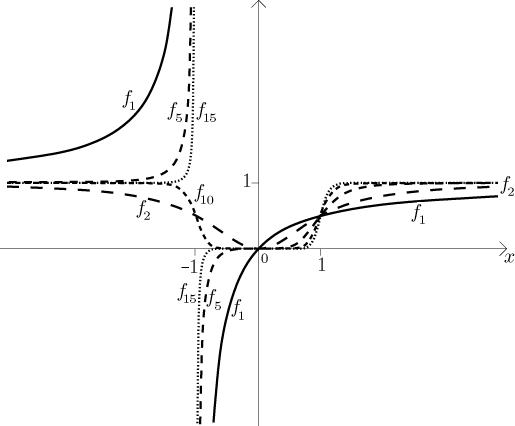Problem: Investigate convergence of the following sequence of
functions:

Solution:
Before we start, note that the point x = −1 is
not in the domain of functions with odd k, therefore we exclude it
from all our considerations right away.
First we investigate pointwise convergence. We treat x as a parameter
and evaluate limit with respect to k. When we send k to
infinity, then the limit of xk depends
on x, see
geometric
sequence. Therefore we have to adopt three distinct strategies when
evaluating this limit. For
|x| < 1 the terms
xk disappear; for
|x| > 1 they become dominant and the best
approach is to get rid of them by canceling; when
x = 1 then all functions have the same
value and we get a constant sequence.

Conclusion: The given sequence converges on the region of convergence
consisting of all numbers except x = −1
to the function

How about uniform convergence? We start by investigating the difference
between f and a particular fk on the above
region of convergence. Again, we have to do our exploration separately on
three regions. First, at x = 1 the difference
is always zero. For |x| < 1 we get

The critical point x = 0 is obviously a local
minimum of the given function (in absolute value), so the supremum is given
by values at endpoints. The limit at 1- yields 1/2,
so the supremum is at least 1/2 for all k and therefore
we cannot get uniform convergence on
(−1,1). Note that things get equally bad at −1. If k is
even, then the limit at (−1)+ is again
1/2, but if k is odd, the limit there is actually minus
infinity!
Uniform convergence on the whole region of convergence has just been ruled
out, but to get the whole picture we also check on the two intervals given
by |x| > 1.

We see that the expression in the supremum is increasing for
x > 1 and monotone for
x < −1 (increasing if k is even,
decreasing for k odd). The supremum is therefore given by values at
endpoints. Limit at infinity and minus infinity is 0, so there is no
problem. Limit at 1+ is 1/2, so the supremum over
x > 1 is 1/2 and uniform
convergence is ruled out there. Finally, also for
x < −1 we do not get uniform convergence,
the limit (and supremum) being either 1/2 (for k even)
or infinity (for k odd).
We see that uniform convergence is hurt by behavior of the given sequence
on both sides of 1 and of −1. This suggests that if we cut away these
points, then we do get uniformity. Our observations about monotonicity
suggest that when we choose some a > 0 (and for the middle
interval to work a must be small, less than 1), then we
should get uniform convergence on intervals
M = (−∞,−1-a],
M = [−1+a,1-a], and
M = [1+a,∞).
We confirm this
by evaluating the corresponding suprema for these three sets.

Conclusion: The given sequence converges to the function f
uniformly on sets of the form
M = (−∞,−1-a],
M = [1+a,∞),
M = [−1+a,1-a]
for any a > 0 (in the last case we also require that
a < 1).
For illustration we show a picture with some of the functions.

Next problem
Back to Solved Problems -
Series of functions
![]()





